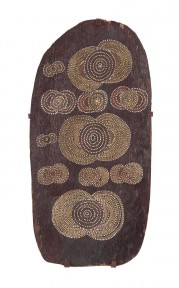Lot #6 - Artist Unknown
-
Auction House:Mossgreen
-
Sale Name:Australian Indigenous & Oceanic Art
-
Sale Date:06 Jun 2016 ~ 6.30pm
-
Lot #:6
-
Lot Description:Artist Unknown
(Port Keats)
Untitled (circa 1960s)
natural earth pigments on ecalyptus bark
63 x 31.8 cm -
Provenance:Private collection, Sydney
-
Notes:An intriguing painting that has been separated from its documentation, it most likely originates from Wadeye (Port Keats) on the coast to the west of Darwin in the Fitzmaurice/Daly River basin, in the lands of the Murrinh-patha, Djamandjungan and related peoples. The people of the region have had extensive ceremonial and exchange relations with peoples to the north, west to the Kimberley and south to the Western Desert. Painting on sheets of flattened eucalyptus bark was introduced to the Wadeye region in the 1950s through the Christian mission that had been established two decades earlier, as a means of raising funds for the community. Wadeye bark painters continued the visual lexicon of the region that is found in paintings on rock and ritual objects, as well as the more ephemeral forms of body and ground painting. The corners of Wadeye barks are usually rounded to imitate the shape of painted or incised ritual boards. A striking feature of the classical style of Wadeye painting is the incorporation of design elements similar to the iconography of desert art. This is a particularly clear example, featuring sets of concentric circles reminiscent of paintings from Papunya in the Western Desert in the 1970s. Paintings by artists such as Shorty Lungkata Tjungurrayi and John Tjakamarra come to mind: see Tjungurrayi’s Men’s Ceremony, 1972-3, and Special Homeland Dreaming, 1973 in Bardon and Bardon 2004, painting numbers 376 and 423, pp. 413 and 451 respectively, and Tjakamarra’s Kiritjinya, 1975, in Johnson 2007, p.77. However, the dotted roundels are also common in Wadeye paintings: see in particular Christopher Pugar’s Life, c.1960s, in the Arnott’s Collection at the Museum of Contemporary art, which features a Tingari-like matrix of roundels joined by straight lines (illustrated in Mundine 2008:219), and Nym Bandak’s The Artist’s Country, c.1955, in the collection of the National Gallery of Australia (see Cubillo and Caruana 2010:107). Wally Caruana References: Bardon, G. and J. Bardon, Papunya, A Place Made After the Story: The Beginnings of the Western Desert Painting Movement, The Miegunyah Press, Melbourne, 2004; Cubillo, F. and W. Caruana (eds), Aboriginal & Torres Strait Islander Art: Collection highlights, National Gallery of Australia, Canberra, 2010; Johnson, V. (ed.), Papunya painting, National Museum of Australia Press, Canberra, 2007; Mundine, D. et al, They are Meditating: Bark paintings from the MCA’s Arnott’s Collection, Museum of Contemporary Art, Sydney, 2008.
-
Estimate:A$8,000 - 12,000
-
Realised Price:
-
Category:Art
This Sale has been held and this item is no longer available. Details are provided for information purposes only.













